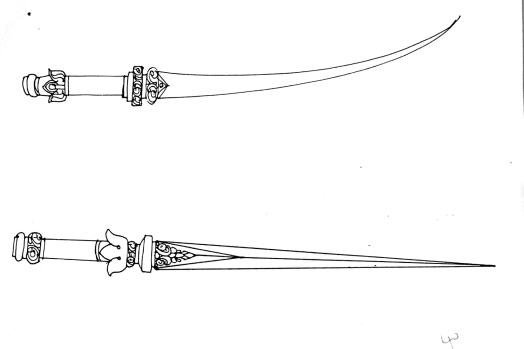Nitiprakasika (Critical Analysis)
by S. Anusha | 2016 | 34,012 words
This page relates ‘Sarga III: Khadga-utpatti-kathana (40 Verses)’ of the study on the Nitiprakasika by Vaisampayana which deals primarily with with Dhanurveda, i.e., the science of war, weapons and military strategies of ancient Indian society. It further contains details on Niti-shastra, i.e., the science of politics and state administration but most verses of the Nitiprakashika deal with the classification and description of different varieties of weapons, based on the four groups of Mukta, Amukta, Muktamukta and Mantramukta.
Sarga III: Khaḍga-utpatti-kathana (40 Verses)
verses 1-10: Khaḍga praśaṃsā:
Pṛthu proceeded to ask Brahmā about the origin of Khaḍga. He asked the creator about the reason and time for creation of sword as well as its parampara.
Brahmā begins with the extolation of Khaḍga–even when one‘s bow is broken and horses are dead or incapacitated, the Khaḍga will save the warrior in the battlefield. A Khaḍgadhara is capable of facing warriors who possess weapons like Gadā or Śakti. It is the “weapon of weapons” (āyudhabhyo varaḥ bhadgaḥ) and was created for subduing the asuras who transgress their limits.
verses 11-20: Emergence of Khaḍgapuruṣa
The Khaḍga was created in the Himalayan regions, well known for its vegetative bounty and wealth of metals. The creator himself performed penance for about thousand years after which certain portents appeared foretelling the occurrence of a miracle. A brilliant Khaḍgapuruṣa who had a frightening form and fearsome roar emerged.
A list of portents foretold the arrival of such a strange being–the Earth trembled; ocean agitated; meteors showered and huge branches fell off trees. This Khaḍgapuruṣa then shed his frightening form and got transformed into the Khaḍga.
verses 21-8: Śiva’s use of Khaḍga in destroying demons:
Brahmā then placed the Khaḍga in the hands of Lord Śiva, who tested the weapon by moving it in different ways; he used it to annihilate the demons by wielding it in thirty-two different movements, moving his feet accordingly swiftly; he vanquished the demons in the battle.
verses 29-35: Khaḍga–Its Paramparā:
Pleased with the possible uses of the khaḍga, Lord Śiva then, in turn, passed it on to Viṣṇu who gave it to Marīcī. From Marīcī, the sages, Vāsava, Lokapāla and Manu obtained the sword in sequence and used it to uphold dharma. Saying so about the lineage of the sword, Brahma handed over the weapon to Pṛthu, to take care of the subjects just like his progeny
verses 36-40: Conclusion of the third sarga:
Brahmā claims supremacy for the Khaḍga -as the foremost amongst the śastras. Its nakṣatra is kṛttika, gotra is rohiṇī and devatā is rudra. The warriors upon worship of Khaḍga become victorious and famous.
Weapon: KHAḌGA{GL_NOTE::} [III. (24- 8)]

Measurements:
50 angulas ln.
4 aṅgulas wide
BRIGHT, SHARP-EDGED, UPRIGHT
Physical Characteristics
1. Bhrānta,
2. Udbhrānta,
3. Āviddha,
4. Āpluta,
5. Vipluta,
6. Sṛta,
7. Samyānta,
8. Samudīrṇa,
9. Nigraha,
10. Pragraha,
11. Pādāvakarṣa,
12. Sandhāna,
13. Śiroparibhrama,
14. Bhujaparibhrama,
15. Pāśa,
16. Pāda,
Movements:
17. Vibandha,
18. Bhūmi,
19. Udbhrāmaṇaka,
20. Gata,
21. Pratyāga,
22. Ākṣepa,
23. Pātana,
24. Utthānaka,
25. Pluta,
26. Lāghava,
27. Sauṣṭava,
28. Śobhā,
29. Sthiratva,
30. Dṛḍhamuṣṭitā,
31. Tiryakpracaraṇa,
32. Ūrdhvapracaraṇa,
Tattvavivṛti on verses 24-8:
Succinct explanation of the thirty two movements of Khaḍga is provided.
